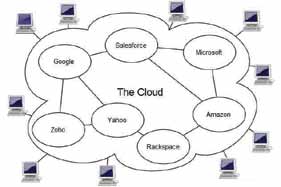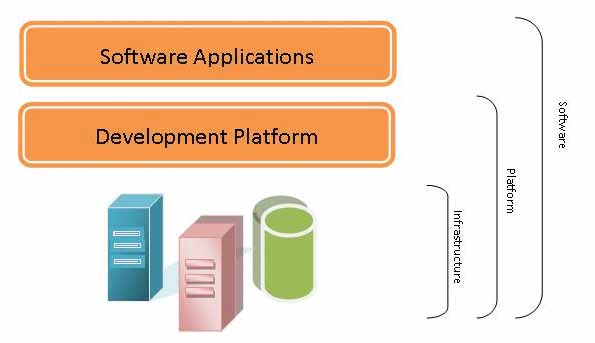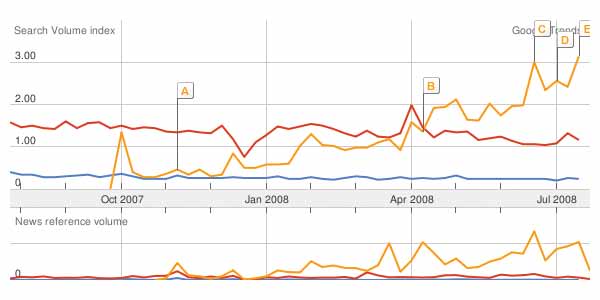Google’s chief executive Eric Schmidt publicly uttered the term ‘cloud computing’ in 2006. Since then the term has taken technology by a storm. Cloud computing is all the rage now. “It’s become the phrase du jour,” says Gartner’s senior analyst Ben Pring, echoing many others.
To different people there seems to be a different definition of cloud computing. An appropriate definition, however, is “Internet-based computing where shared resources, software and information are provided to computers and other devices on demand, like the electricity grid.”
Cloud computing is a harmonised technology with scalable business policies. It is a versatile and flexible application of the Internet that promises to offer services like that of cloud or sky: Anytime, anywhere, by using the Internet and central remote servers to maintain data and applications. Consumers and businesses can use applications without installing any server or software.

Fig. 1: Example of cloud computing
Consider examples of hotmail.com, yahoo.com or gmail.com where no installation of server or software is required. all you need to access them is an Internet connection. These are simple examples of cloud (Internet) computing (Fig. 1). Centralising the storage, memory, processing and bandwidth allows for much more efficient computing.

Benefits of cloud computing
One of the strongest appeals of cloud computing is its ability to contract with an Internet provider for accessing the huge amount of unused or underused computational resources to deliver an amazing ‘bang for the buck’ computing platform with very little capital expenditure but a high-bandwidth link to the Internet.
As far as services are concerned, sky is the limit. Cloud computing provides services on demand via a secure online environment referred to as the ‘cloud.’ Customers enjoy services like e-mail, Web publishing, office tools and HR applications on a subscription basis, without installing software, buying licences or having to manage information and communication technology (ICT) infrastructure.

Bill Chang, SingTel’s (Singapore Telecomm) executive vice-president for business group, says, “Cloud computing allows businesses to improve their productivity, yet cut their ICT costs by up to 90 per cent. It is gaining momentum globally as broadband and smart devices become more pervasive and affordable, and virtualisation technologies mature. We expect this market to grow even faster with the launch of Singapore’s ultra-fast Next Generation National Broadband Network in 2012.”
A Web definition best suited to the objective of cloud computing is that “It refers to a computing system in which tasks are assigned through a combination of connections, service and software over a network. This collection of connections is known as ‘the cloud.’ Computing at this level allows users to sort through a vast amount of data. For example, Google is currently the forerunner of cloud computing due to its need to produce accurate and instant results for millions of search queries it receives every day.”
[stextbox id=”info”]Cloud computing is not immune to risks and ethical objections, but the fact is that it promises big changes[/stextbox]
Components of cloud
Cloud computing is broken down into three segments: applications, platforms and infrastructure. Each segment serves a different purpose and offers different products for businesses and individuals around the world. Software as a Service (SaaS) optimises cost and resources, Platform as a Service (PaaS) creates, deploys and secures applications and services, and Infrastructure as a Service (IaaS) selects and commissions a computing infrastructure as a fully outsourced service (see Fig. 2).
SaaS delivers a single application through the browser to thousands of customers using a multi-tenant architecture. This gives a huge monetary relief to customers and users. No investment for installation of server and software licencing is required.
Examples of SaaS are wordprocessing, financial services, human services, e-mails cloud and sales accounting.
PaaS delivers development environments as a service which allows customers to build their own applications that run on the provider’s infrastructure and are delivered to users via the Internet from the provider’s servers. It provides a platform in the cloud, where applications can be developed and executed.
Examples of PaaS are google, gmail engines, etc.
IaaS, also known as Everything as a Service (EaaS), is delivery of resources such as CPU, memory, networking and security as a service. It is the virtual machine in cloud computing. IaaS provides a platform to customers to choose from a range of operating systems (usually, some flavour of open source), size for hardware (number of CPUs and CPU power) and amount of memory.
It appears that IaaS and PaaS have little difference, but that is not true.
A major difference between IaaS and PaaS is the amount of control over the system available to customers for the services. IaaS provides total control, while PaaS typically provides no control. also, PaaS has virtually zero administration cost, whereas IaaS has administration costs similar to a traditional computing infrastructure.
Other characteristics of IaaS include resource sharing, on-demand service, rapid deployment, location independence, lower total cost for customer (pay for use), full scalability, no need for administration and maintenance of hardware, and enterprise-grade infrastructure for all customers.
The examples of IaaS are Fexiscale and AWS: EC2.
Way forward
Whether cloud computing is a hype or hope, that’s yet to be ascertained. The challenge is to provide services quickly and cost-effectively. also in the race are technologies like cluster and grid computing. The three technologies, however, are not fairly distinguishable (Fig. 3), and which one will emerge as the winner is not clear.
Cloud computing is not immune to risks and ethical objections, but the fact is that it promises big changes. Leonard Kleinrock, one of the chief scientists at Advanced Research Projects Agency Network (ARPANET) that paved the way for today’s Internet, said in 1969, “as of now, computer networks are still in their infancy, but as they grow up and become sophisticated, we will probably see the spread of ‘computer utilities’ which, like present electric and telephone utilities, will service individual homes and offices across the country.” This vision of the computing utility is taking shape with cloud computing.
If the recent market research is any indication, cloud computing may become a billion dollar market by 2012. So we can say that the Internet industry is on the Cloud!
The author is a regular contributor to EFY








